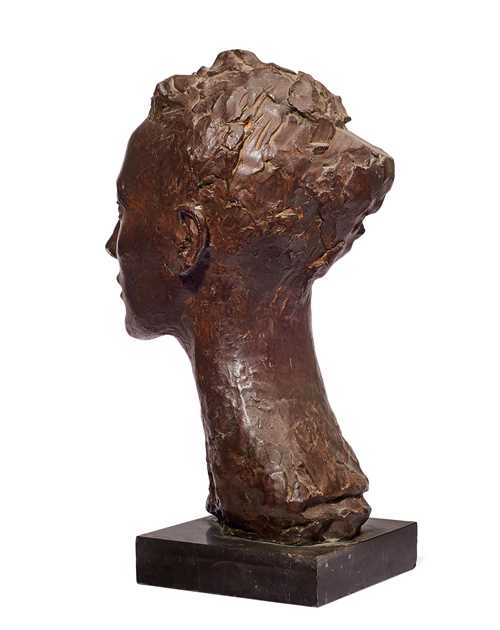
Lotto 3226 - A191 Impressionismo e arte moderna - venerdì, 06. dicembre 2019, 16h30
GERMAINE RICHIER
Literature:
- Frehner, Matthias (ed.): Germaine Richier - Retrospektive, Kunstmuseum Bern, p. 72, no. 14 (with ill.; different cast).
- Lammert, Angela/Merkert, Jörn: Germaine Richier, Akademie der Künste Berlin 1997, p. 105, no. 8 (with ill.; different cast).
- Prat, Jean-Louis: Germaine Richier, Retrospektive, Fondation Maeght, Saint-Paul-de-Vence 1996, p. 28, no. 4 (with ill.; different cast from the family of Germaine Richier).
A pioneering figure of the 20th century avant-garde, Germaine Richier’s work is considered today as one of the most important contributions made to the modern tradition of sculpture. Beginning in 1920 she studied at the École des Beaux-Arts in Montpellier with Louis Jacques Guigues, a former collaborator of Auguste Rodin. In the second half of the 1920s, she studied with Émile-Antoine Bourdelle, himself a pupil of Rodin. Her training is therefore doubly formed by an art historical lineage to Rodin. Connected with this is the overcoming of frozen, academic traditions on one hand, and also the prevailing Realism on the other. For a long time, the artistic-historical significance of Richier's work was classified as the completion of the traditions that ended in the course of the 20th century, and as the final point of expressive realism. However, this fails to recognise her modernity, in that she often gave her figurative sculptures a sense of alienation resembling a Kafkaesque questioning of reality. Today her work is no longer seen as the conclusion of a development, but rather as an orientation for later artists. Her work anticipates many important approaches, such as those of Georg Baselitz and Rebecca Warren. In some figures, Richier spans wires that are very reminiscent of Francis Bacon's cages. These lines appear to give stability and an arrangement in space, and thus her work is also to be understood existentially. It is now known that her art-historical importance is in no way inferior to that of Alberto Giacometti, also a pupil of Bourdelle. As Germaine Richier died early, in 1959, she was denied the appropriate widespread recognition for a long time.
The two works offered here, the bronze bust "Regodias" and the plaster cast of "Le Crapaud" (Lot 3227) beautifully demonstrate Richier's existing ties to tradition and to Realism, which is nonetheless endued with idealising and surreal elements. Both sculptures come from the estate of an artist friend who received the works directly from Richier.
Produced in 1938, the bronze bust portrays the professional model of Renée Regodia. Numerous sketches express the artist’s painstaking search for form. The classic technique of Bourdelle's triangulation method, which constructs the surface using a network of triangles, has here been adopted by Richier. This can be seen in the plaster painted over with blue lines of the bust that was occasionally presented at exhibitions. The proportions are perfect and clearly indebted to observed symmetries. The calm effect of the bust is based on an idealised aesthetic borrowed from antique models. On the occasion of the important retrospective at Galerie Maehgt in 1996, Jean Louis Prat compared the bust of Regodia with that of the Berlin Nefertiti.
While Germaine Richier remained true to the human figure throughout her entire career, she nonetheless alienated it to an extent through animal gestures and postures. The most important subjects in Germaine Richier’s work include these so-called hybrid beings or insect humans. In a sense, they draw near to the human being from below: she named the early female nude offered here "Le Crapaud", thus "the toad". In doing so, she thwarted all erotic associations of sculptures with comparable female nudes crouching on the ground.
" Je suis le contraire de l’abstrait, mais les lois de l’abstraction ont une grande importance sur moi. " Germaine Richier.
CHF 10 000 / 15 000 | (€ 10 310 / 15 460)
Venduto per CHF 83 260 (incl. premio dell'acquirente)
Non si assume alcuna responsabilità per la correttezza di queste informazioni.









